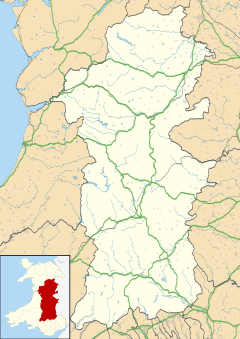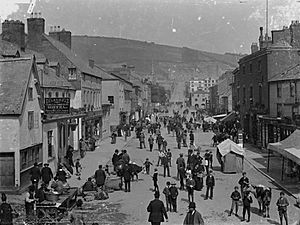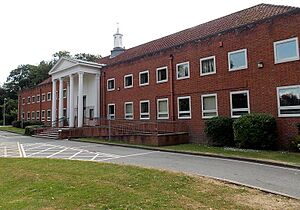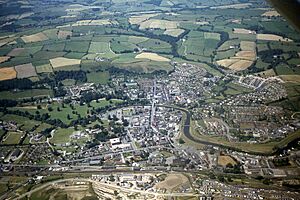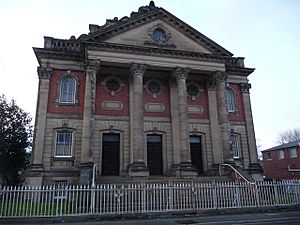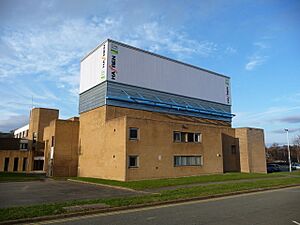Newtown, Powys facts for kids
Quick facts for kids Newtown
|
|
|---|---|
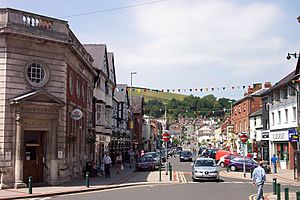 Newtown town centre |
|
| Population | 11,362 (2021) |
| OS grid reference | SO115915 |
| Community |
|
| Principal area | |
| Ceremonial county |
|
| Country | Wales |
| Sovereign state | United Kingdom |
| Post town | NEWTOWN |
| Postcode district | SY16 |
| Dialling code | 01686 |
| Police | Dyfed-Powys |
| Fire | Mid and West Wales |
| Ambulance | Welsh |
| EU Parliament | Wales |
| UK Parliament |
|
| Welsh Assembly |
|
| Website | www.newtown.org.uk |
Newtown (Welsh: Y Drenewydd) is a lively town in Powys, Wales. It sits right on the River Severn and is part of the Newtown and Llanllwchaiarn community. Historically, it was part of Montgomeryshire. In 1967, Newtown was chosen to be a "new town," which meant it grew a lot as businesses and people moved there. This changed it from a quiet market town to a busier place. Its population has grown steadily, reaching 11,362 people in 2021.
Newtown is famous as the birthplace of Robert Owen in 1771, a very important social reformer. Today, the town has a theatre called Theatr Hafren and an art gallery, Oriel Davies, which shows modern art. It's the biggest town in both Powys and Mid Wales.
Contents
- What's in a Name? The Story of Newtown's Name
- A Look Back: Newtown's History
- How Many People Live in Newtown?
- Who Runs Newtown?
- Newtown's Location and Surroundings
- Important Buildings and Landmarks
- Places for Arts and Culture
- Getting Around: Transport in Newtown
- Newtown's International Connections
- Famous People from Newtown
- Sports in Newtown
- Learning in Newtown: Schools and Education
- Images for kids
- See also
What's in a Name? The Story of Newtown's Name
Newtown's first recorded name was Llanfair-yng-Nghedewain. This old Welsh name came from a church dedicated to St Mary in an area called Cedewain.
The names "Newtown" (English) and "Nova Villa" (Latin) first appeared in the 1200s. This was after the Norman invasion of Wales. Robert Owen, a famous person from Newtown, said the name "Newtown" was used to tell it apart from an older Norman power centre in Powys called Caersws.
Even today, the modern Welsh name for the town is Y Drênewydd. This name was influenced by Newtown being one of only two "new towns" suggested for Wales in 1949.
A Look Back: Newtown's History
How Newtown Started
Long ago, in the early medieval period, a small village called Llanfair-yng-Nghedewain existed where Newtown is now. It was located near a crossing point on the River Severn and close to the church of St Mary.
In the 1200s, the English Crown became interested in this area. Llywelyn ap Gruffudd, the Prince of Wales, built a new administrative centre at Dolforwyn Castle near Abermule. This happened after a peace agreement, the Treaty of Montgomery, between him and Henry III of England. Llywelyn built the castle to secure his new lands.
However, after Henry III died in 1272, tensions grew with the English at Montgomery Castle. This led Edward I of England to capture Dolforwyn Castle in 1277. He then gave Llywelyn's lands to a powerful lord named Roger Mortimer. Mortimer decided to move the administration from Dolforwyn Castle to a new settlement he planned to build further down the valley – this new place became Newtown. The town was given permission to hold a market in 1279.
Once Wales was fully under English control by 1282, Newtown was developed as an "English plantation town." This was part of Edward I's plan to strengthen English power in Wales.
Growing with Industry
Newtown grew a lot in the 1700s and 1800s. It became a centre for the textile and flannel industry. The completion of the Montgomery Canal also helped the town's growth. In 1838, Newtown was the site of Wales's first Chartist demonstration, where people protested for more rights.
The Cambrian Mills, which opened in 1856, were the first steam-powered mills in Newtown. They were located by the canal and became the largest woollen mills in Wales. However, by the late 1800s, Newtown's mills struggled to compete with bigger mills in northern England. After two big fires in 1910 and 1912, the Cambrian Mills were not rebuilt. Newtown then stopped being a major woollen industry centre, and many workers moved away.
Newtown hosted the National Eisteddfod (a major Welsh cultural festival) in 1965. In 1967, the town was officially named a "new town." This led to a big increase in population as new businesses and people arrived, changing its quiet, rural market town feel.
How Many People Live in Newtown?
The population of Newtown was 10,780 in 2001. It grew to 11,347 in 2011 and then to 11,362 people in the 2021 census.
Who Runs Newtown?
Newtown has two main levels of local government. These are the Newtown and Llanllwchaiarn Town Council and the Powys County Council.
The Town Council has 16 elected members who serve for five years. They mainly look after green spaces and public facilities. They also act as a voice for Newtown's residents. The Council Chair or Mayor is chosen by the councillors.
Newtown is represented on Powys County Council by five county councillors. Each councillor represents a different area of the town.
Newtown's Location and Surroundings
Newtown is about 8 miles (13 km) from the Wales-England border. It lies in a narrow valley of the River Severn. This means that new buildings mostly happen north and south of the town. Many small villages surround Newtown, and they are often called the "Newtown area." The wider Newtown area, including these villages, has a population of almost 16,000 people.
Important Buildings and Landmarks
The Pryce Jones Royal Welsh Warehouse is the tallest building in Newtown. It was built by Pryce Pryce-Jones. This building was home to the world's first mail order service!
Bear Lanes, the main shopping centre, has a Tudor-style entrance. This building used to be a hotel called The Bear, which gives the shopping centre its unique look today.
The Robert Owen Museum is located in the council offices on Broad Street. A statue of Robert Owen was put up in 1956 in a park. A copy of this statue was later placed in Manchester.
The Free Library building was designed by architect Frank Shayler and built in 1902. The Baptist Chapel, built in 1881, is a great example of nonconformist church architecture from that time.
Places for Arts and Culture
- The Hafren theatre – a large venue with 555 seats. It's home to the Mid Wales Opera.
- Powys Theatre – where the Newtown Amateur Dramatic Society performs.
- Robert Owen Museum – learn about the famous social reformer.
- Textile Museum – discover the history of the town's textile industry.
- W H Smith Museum (above the shop) – a museum about the famous book and stationery retailer.
- Oriel Davies – the biggest visual arts venue in the region, showing modern art and crafts.
Getting Around: Transport in Newtown
Newtown's train station is on the Cambrian Line. Trains run about every two hours.
Local bus services are run by private companies. Newtown also has one National Express bus each day that goes to Aberystwyth and to London. There's also a TrawsCymru bus route to Cardiff and another to Machynlleth and Wrexham. Two main roads meet in Newtown: the A483 (from Swansea to Chester) and the A489 (from Machynlleth to Craven Arms). A new bypass road south of Newtown opened in 2019, after being planned for a long time.
The Montgomery Canal used to end in Newtown. After it closed in 1944, parts of the canal area were sold for building. However, the names Canal Road and Lower Canal Road still remind us of its past.
Newtown's International Connections
Twin Towns
Newtown is twinned with Les Herbiers, a town in Pays de la Loire, France. This means they have a special friendship and often exchange visits.
Famous People from Newtown

Many notable people have connections to Newtown:
- Robert Owen (1771–1858) – A very important social reformer. He helped start the Co-operative Movement.
- Pryce Pryce-Jones (1834–1920) – A pioneer in mail-order shopping, born nearby.
- Barry Hoban (born 1940) – A professional cyclist who won several stages in the Tour de France.
- Phil Mills (born 1963) – A co-driver who won the World Rally Championship.
Sports in Newtown
Newtown A.F.C. is Newtown's main association football (soccer) club. They were one of the first teams in the Welsh Premier League in 1992. The club started in 1875 as Newtown White Stars and won the Welsh FA Cup twice. They play at Latham Park, which can hold 5,000 fans. This stadium has a special licence for international under-21 games and European matches.
Newtown RFC is the town's rugby union club, started in 1925. They have several teams, including youth and junior teams.
Newtown also has places for other sports like lawn bowls, cricket, golf, and tennis. A basketball club, the Newtown Titans, was set up in 2005.
Learning in Newtown: Schools and Education
Newtown has several schools for different age groups:
- Ysgol Robert Owen (for special needs)
- Ysgol Calon y Dderwen (ages 4–11)
- Ysgol Dafydd Llwyd (ages 4–11)
- St Mary's (ages 4–11)
- Penygloddfa (ages 4–11)
- Maesyrhandir (ages 4-11)
- Treowen (ages 4–11)
- Newtown High School and Sixth Form (ages 11–18)
Newtown High School received an excellent inspection report in 2015. It was praised for its good relationships between teachers and students, and for supporting students in many different subjects after age 16.
Images for kids
-
Robert Owen, 1834
See also
 In Spanish: Newtown (Gales) para niños
In Spanish: Newtown (Gales) para niños


